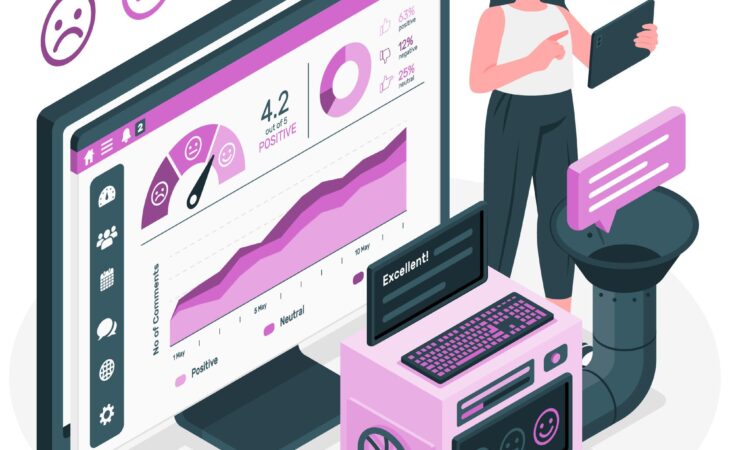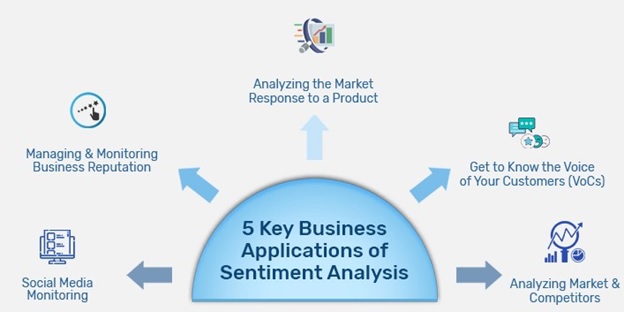Welcome to Ibex Analytics
- +14253899644
- 14121 Tukwila International Blvd, Tukwila WA 98168
- info@ibexanalytics.net
Welcome to Ibex Analytics

Opinion mining, or sentiment analysis, is the practice of sifting through textual and digital data in search of expressions of opinion. This can include figuring out the overall tone of a document or a passage within a document, as well as finding and extracting specific subjective information like opinions, evaluations, appraisals, and emotions.
Sentiment analysis can be used in many ways in business, such as:
Marketing:
Companies can use sentiment analysis to keep track of how customers feel about their brand, products, and campaigns on social media and other online platforms and to figure out what those feelings are.
Service to customers:
Sentiment analysis can be used to automatically sort and rank customer support tickets and online reviews, making it easier for companies to respond to customer needs and complaints.
Product development:
Sentiment analysis can be used to find ways to improve existing products and to help come up with ideas for new ones by figuring out what customers want and need.
Risk management:
By keeping an eye out for negative comments on social media and other online platforms, sentiment analysis can be used to find potential risks and issues before they become big problems.
Competitive intelligence:
Companies use sentiment analysis to keep an eye on and learn about their competitors by finding out how people feel about their products on the market. This helps them figure out what to do next. Sentiment analysis is the process of figuring out how a customer feels about something in writing. By listening to what people are saying online, businesses can figure out how their customers feel about things by analyzing the context of identifying information.

Fig 1. Business applications of sentimental analysis
1. Tracking a brand
A brand is not the same thing as the product it makes. It depends on how online marketing, social campaigns, content marketing, and customer support services are used to build a brand. Sentiment analysis is a powerful tool for understanding consumer opinion of a product, brand, or business from every angle. Customer sentiment may be gauged through sentiment analysis. By looking at social media and surveys, you can learn a lot about what your customers like and don’t like about your business.
Companies often use sentiment analysis as a powerful tool to find out how their products and campaigns affect their customers and other important people. With brand monitoring, you can learn a lot from what people say about your brand in the market. With sentiment analysis, you can automatically sort brand mentions by how important they are and send them to the right team.
2. Service to customers
Companies that provide customer service often use sentiment analysis to automatically sort calls from users into “urgent” and “not urgent” groups. The classification is based on the tone of the emails or on knowing ahead of time which calls come from customers who are upset. Customers want their interactions with companies to be easy to understand, personal, and quick. So, service providers focus more on the most important calls to fix users’ problems and keep their brand’s value. So, you should look at how your employees help customers to make sure they are using the right process. Also, make your services more efficient so that customers don’t have to wait around for help for as long.
4. Business Intelligence Buildup
Digital marketing is an important part of running a business. The reactions and reviews of the product are often shown on social media. When you know how people feel about your company and new products, it’s much easier to guess how many of your customers will stick with you. With sentiment analysis, you can find out how well your product does on the market and what else needs to be done to boost your sales. You can also look at how your competitors have responded. Based on what the survey tells you, you can better meet your customers’ needs. You can make decisions right away that will help you adjust to how the market is right now.
5. Making things better for the customer
If a customer has a good experience, they are more likely to come back. A business that does well knows that how they deliver is just as important as what they deliver. Brand Monitoring gives us direct, valuable information about how customers feel about our products. But you can also use this analysis on interactions with customer support and surveys. The next step in the NPS survey is to ask people to leave the score and look for open-ended answers, which are called qualitative data. It is much harder to figure out what to do with qualitative surveys. Still, with the help of sentiment analysis, these texts can be put into different groups that give more information about how customers feel.
6. Research on and analysis of the market
Business intelligence uses sentiment analysis to figure out the personal reasons why customers like or dislike a product, user experience, or customer service. You can do all kinds of market research and competitive analysis with the help of sentiment analysis. It can make a big difference whether you’re trying to break into a new market or get ahead of your competitors. Sociology, psychology, and political science all use sentiment analysis to look at trends, opinions, and ideological bias, as well as to measure reactions and other things.